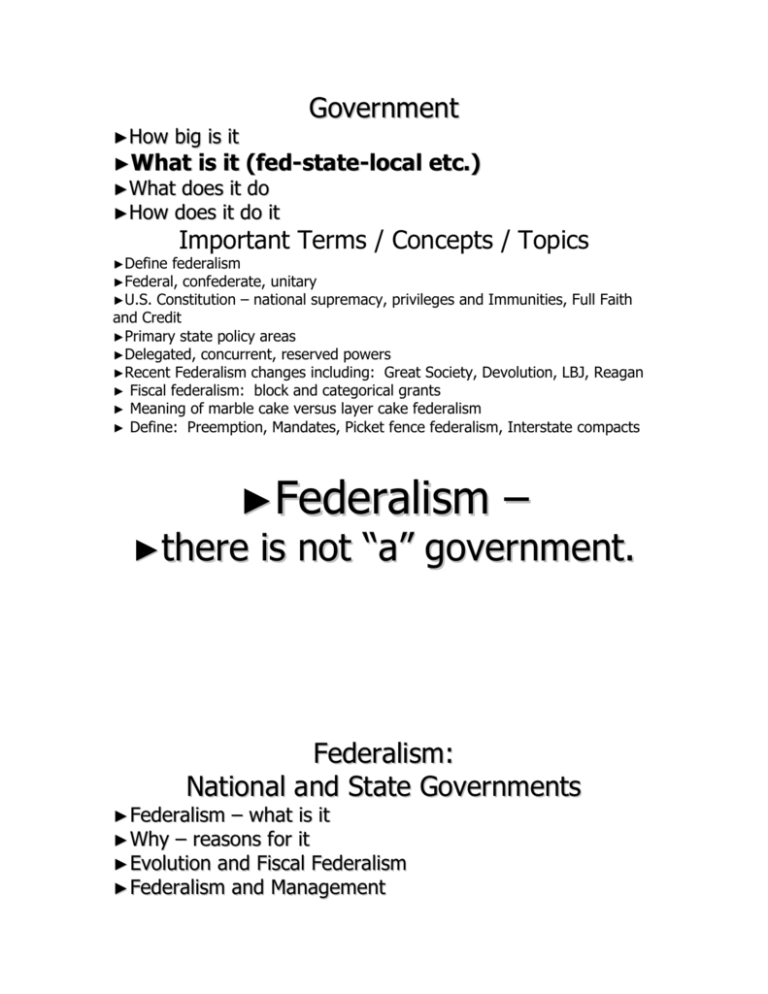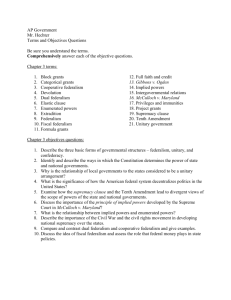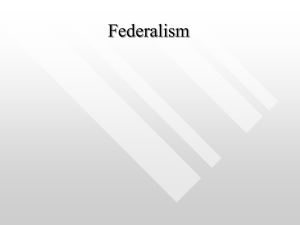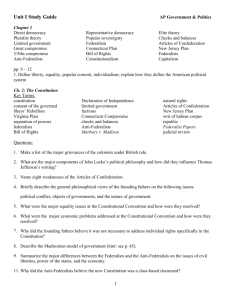Government
advertisement

►How big is it ►What Government is it (fed-state-local etc.) ►What does it do ►How does it do it ►Define Important Terms / Concepts / Topics federalism ►Federal, confederate, unitary ►U.S. Constitution – national supremacy, privileges and Immunities, Full Faith and Credit ►Primary state policy areas ►Delegated, concurrent, reserved powers ►Recent Federalism changes including: Great Society, Devolution, LBJ, Reagan ► Fiscal federalism: block and categorical grants ► Meaning of marble cake versus layer cake federalism ► Define: Preemption, Mandates, Picket fence federalism, Interstate compacts ►Federalism – ►there is not “a” government. Federalism: National and State Governments ► Federalism – what is it ► Why – reasons for it ► Evolution and Fiscal Federalism ► Federalism and Management ►Federalism: a legal division of authority between the federal government and state governments. National – State (Regional) Relationships ► Unitary ► Federal ► Confederate Unitary SOME Unitary Governments Confederation Confederate Governments Federal SOME Federal Governments ► Founders Faced Why Federalism? Little national identity – state/colony focus Little national travel or communication Fear of far-away power ►First choice was a confederacy Provided another control on power of new national government over and above separation of powers / checks & balances ►The Constitution may have never been ratified if the Framers had pushed for a unitary system. Federalism was a compromise, allowing the states to maintain their independence. “Look, the American people don’t want to be bossed around by federal bureaucrats. They want to be bossed around by state bureaucrats” The European Union ► Council of the EU ► European Parliament ► The Commission ► The Court of Justice ► The “Euro” Federalism – What is it? Federalism is Federal-State ONLY ► National Supremacy Clause, Article 6, Clause 2: ► The laws of the United States which shall be made in pursuance (of powers delegated to federal government), and all treaties made . . . . under the authority of the United States, shall be the supreme law of the land; and the judges in every state shall be bound thereby, any thing in the Constitution or laws of any state to the contrary notwithstanding. ►Privileges State to State and Immunities, Article 4, Section 2, Clause 1: ► “The Citizens of each State shall be entitled to all Privileges and Immunities of Citizens in the several States.” ►Full ►“ State to State Faith and Credit, Article 4, Section 1: Full Faith and Credit shall be given in each State to the public Acts, Records, and judicial Proceedings of every other State.” And the Congress may by general Laws prescribe the Manner in which such Acts, Records and Proceedings shall be proved, and the Effect thereof. Primary State Powers ► Exist, but are not ► Amendment #10 spelled out anywhere “The powers not delegated to the United States by the Constitution , nor prohibited by it to the States, are reserved to the States respectively, or to the people.” ► Some claim this is a meaningless truism: States have whatever power the federal government does not take ► Protection of state power is partially ► But more importantly political constitutional The U.S. Senate represents the states House members are selected by state Primary State Policy Areas Liberal to Conservative by State State Laws on Concealed Handguns Executions by state: 1976-2005 Different Policies--Education State grades on Abortion Accessibility from NOW (Social Conservatives Reverse: F = A) Evolution of Federalism ► State-centered, @ 1789-1865 ► Dual, @ 1865-1913 ► Cooperative, @ 1913-1964 ► Centralized, @ 1964-1980 ► Devolution or New Federalism, @1980-? Changes to federalism stem from Federalism – Original Design ► Governing powers divided into Delegated Concurrent Reserved Delegated, Concurrent, Reserved The Original Design of Federalism The Original Design of Federalism State centered @ 1789-1865 Almost all important decisions made at state level Power of national government unclear Chief Justice John Marshall, 1801–1835 ► Marbury v. Madison, 1803 ► McCulloch v. Maryland, 1818 –used Constitution’s necessary and proper clause ► His opinions helped to weaken states’ rights. McCulloch v. Maryland (1819) “Let the end be legitimate, let it be within the scope of the Constitution, and all means which are appropriate, which are plainly adapted to that end, which are not prohibited, but consist with the letter and spirit of the Constitution, are constitutional.” “The power to tax involves the power to destroy…If the right of the States to tax the means employed by the general government be conceded, the declaration that the Constitution, and the laws made in pursuance thereof, shall be the supreme law of the land, is empty and unmeaning declamation.” Evolution of Federalism ► Doctrine of Nullification ► Doctrine of Secession Each state could declare any laws or actions of the national government “null and void.” States could choose to withdraw from the United States if they wanted. Used by the Confederate States in the Civil War. Dual Federalism , @ 1865-1913 Evolution of Federalism “Dual Federalism” 1868 to 1913 In this phase, the national government narrowly interpreted its delegated powers and the states continued to decide most domestic policy issues. ► Cooperative, @ 1913-1964 Federal government adopts an income tax, 1913, amendment #16 Direct election of us Senators, 1913, amendment # 17 ►Senators now represented people, not state governments Industrial revolution created a national economy vs. prior regional economies WWI, WWII, Cold War all focused attention on national government National programs due to Great Depression Cooperative – Cont. ► With fed’s resources from income tax was able to assist states suffering from the depression ► Grants-in-aid Grants from one level of government to another At this time mostly block grants ►Block = given for very broad ►E.g. education in general purposes ►States could decide how to spend as long as somehow related to education Centralized Federalism, @ 1964-1980 ►Lyndon Baines Johnson ► and The Great Society Centralized Federalism, @ 1964-1980 ► LBJ and Great Society ► Fed govt. used grants for its own policy goals Poverty, pollution, education, urban renewal, consumer safety ► Why? Centralized Federalism – 2 State malapportionment Some state senates represented counties Some lower house districts not redrawn for 50+ years Vast growth in cities and suburbs since the end of WWII But state legislatures controlled by rural counties Centralized Federalism – 3 Though urban and suburban voters had little impact on state government Their votes were important to U.S. Representatives, Senators and Presidential candidates So Federal elected officials wanted to meet constituent needs states were ignoring. ► Partly Centralized Federalism – 4 came from Constitution’s grant to the federal government the ability to regulate interstate commerce Economy is now national rather than local The presidency of Lyndon B. Johnson (1963–1969) ►Johnson’s “Great Society” War on Poverty ►Federal funds were directed to states, local government, and a wide variety of social programs. ► The Fiscal Federalism Fiscal Federalism transfer of funds from one level of government to another ► Federal to state and local is most important, but can also be state to local and local to local ► An important source of revenue for state and local governments. ► Federal grants to states come in the form of categorical grants and block grants. Federal grants to state and local governments Percent of State and Local funds from federal grants ► Grants-in-aid deal with inequities and inefficiencies in the allocation of resources. They can be used to prompt jurisdictions to deal with problems such as pollution that they might not otherwise address on their own. ► They also foster experimentation and serve as incentives to provide more efficient and effective ways to deliver services and address problems. Purposes of Federal Grants to State and Local Governments Devolution / New Federalism, 1980 -- Present ► States changed dramatically after 1960s ► States complained about categorical grants tying their Supreme Court reapportionment decisions Strengthened governorships More professionalized legislatures in some states hands ► Presidents from Carter to G.W. Bush (excepting Bush #1), were former governors. ► Federal Devolution -- 2 government returned responsibility for some programs to the states E.g., Eliminate AFDC, have states create “workfair” requirements ► Sometimes with federal funding assistance, but state management E.g., Medicaid, fed sets basics, many states add features on top ► Ronald Reagan sought to return more power and responsibility to the states ► “Government is not the solution; it’s the problem” -Ronald Reagan Supreme Court and Federalism ► Beginning in 1995, justices interested in granting more deference to state authority gained a slim five-to-four majority in the Supreme Court. ►United States v. Lopez (1995) v. United States (1997) ►United States v. Morrison (2000) ►Printz But . . . . . Federalism issues are often political issues How Congress Set a National Drinking Age The minimum drinking age became a national issue as a result of emotional appeals by groups such as Mothers Against Drunk Driving Proposing Constitutional Amendment on Marriage Management 9/11: President Bush and with New York City Police and Fire workers. 1963: Eisenhower orders federal troops to desegregate Mississippi schools. Governor George Wallace bars the door. Katrina and New Orleans Louisiana Governor Blanco, FEMA Director Michael Brown And where was Mayor Ray Nagin in these negotiations? Preemption Preemption Types MANDATES Unfunded Mandates Mandates ► Age Discrimination Act, 1986 ► Asbestos Hazard Emergency Act, 1986 ► Safe Drinking Water Act, 1986 ► Clean Air Act, 1990 ► Americans with Disabilities Act, 1990 ► No Child Left Behind, 1993 Picket Fence Federalism Percent of Federally Owned Land-West Percent of Federally Owned Land-East Native American Peoples: Reservations in the United States Relations with Indian Nations Interstate Compact Colorado River Compact Important Terms / Concepts / Topics ► ► ► ► Define federalism Federal, confederate, unitary U.S. Constitution – national supremacy, privileges and Immunities, Full Faith and Credit Primary state policy areas ► ► ► ► ► Delegated, concurrent, reserved powers Recent Federalism changes including: Great Society, Devolution, LBJ, Reagan Fiscal federalism: block and categorical grants Meaning of marble cake versus layer cake federalism Define: Preemption, Mandates, Picket fence federalism, Interstate compacts The constitutional provision which prohibits states from discriminating against citizens of other states is known as: ►A ►B ►C ►D ►E intergovernmental powers. the elastic clause. full faith and credit. privileges and immunities. extradition. ►T h e TRUE OR FALSE? supremacy clause of the Constitution mandates that state laws supersede national laws. ►Concurrent TRUE OR FALSE? powers are those exercised by both the states and national government. Which constitutional clause states that each state must recognize the legal actions – such as marriages and drivers licenses – of other states? ► A. ►B ► C. ► D. ► E. The necessary and proper clause The national supremacy clause The full faith and credit clause The privileges and immunities clause The interstate commerce clause TRUE OR FALSE? ►Federal grants to the states to be used for general rather than specific activities are called block grants. ►Ronald TRUE OR FALSE? Reagan primary emphasis as president was to increase the importance of the national government at the expense of decreasing the importance of the states. ► It TRUE OR FALSE? is the national government, not the states, that is in charge of marriage and divorce laws. Which level of government spends the most on elementary and secondary education? ► a. State government ► b. The federal government ► c. Local government ► d. Federal agencies ► Marble cake federalism views the actions of the federal, state, and local governments as clearly distinct. ► Federal moneys given to a state as a block grant will most likely be used to pursue state goals rather than federal goals. ► Devolution is the transfer of power or authority from state governments to the federal government The distribution of funds from the national government to state and local governments is referred to as ► a. dual federalism. ► b. direct federalism. c. cooperative federalism. d. fiscal federalism A _________________ is a regulation, imposed by one government on another, that requires the receiving government to implement certain goals and/or meet certain standards. a. crosscutting requirement b. mandate c. partial preemption d. severance tax Lyndon Johnson's antipoverty initiatives in the areas of housing, job training, medical assistance, etc., were in the form of ► A block grants. ► B land grants ► C tax breaks for the states ► D categorical grants. ► E Unfunded mandates ► ► ►A ►B ►C ►D Devolution is: the return of governmental responsibilities to state and local governments. a federal regulation that appropriates funds to state and local governments. the return of governmental responsibilities to the federal government. a federal regulation that imposes burdens on state and local governments without appropriating enough money to cover costs. What is a federal structure? How does it differ from confederate and unitary ones? What are some of the stages of federalism? What is meant by inter-governmental grants? What is the difference between a block and a categorical grant? What are the National Supremacy, Privileges and Immunities, and Full Faith and Credit Clauses? What is New Federalism (or devolution) and with what president is it most closely associated? National Supremacy, Privileges and Immunities, Full Faith and Credit Marble Cake vs. Layer Cake Federalism Delegated, Concurrent, and Reserved Government Powers Federal vs. Confederate vs. Unitary Fiscal Federalism, Block vs. Categorical Grants LBJ, Reagan, Great Society, Devolution State vs. Federal vs. Local policy areas Preemption and Mandates








